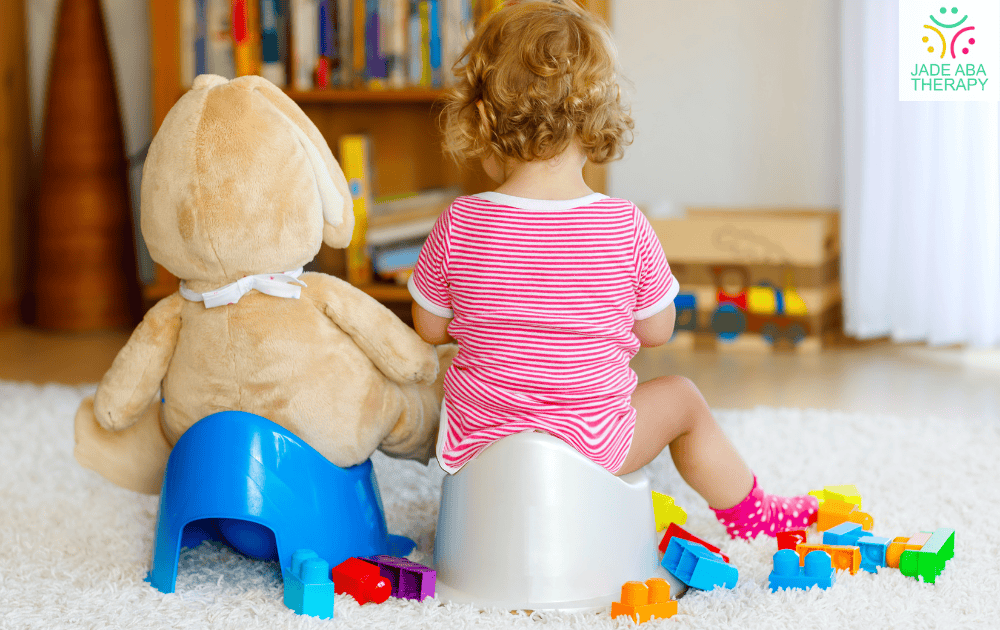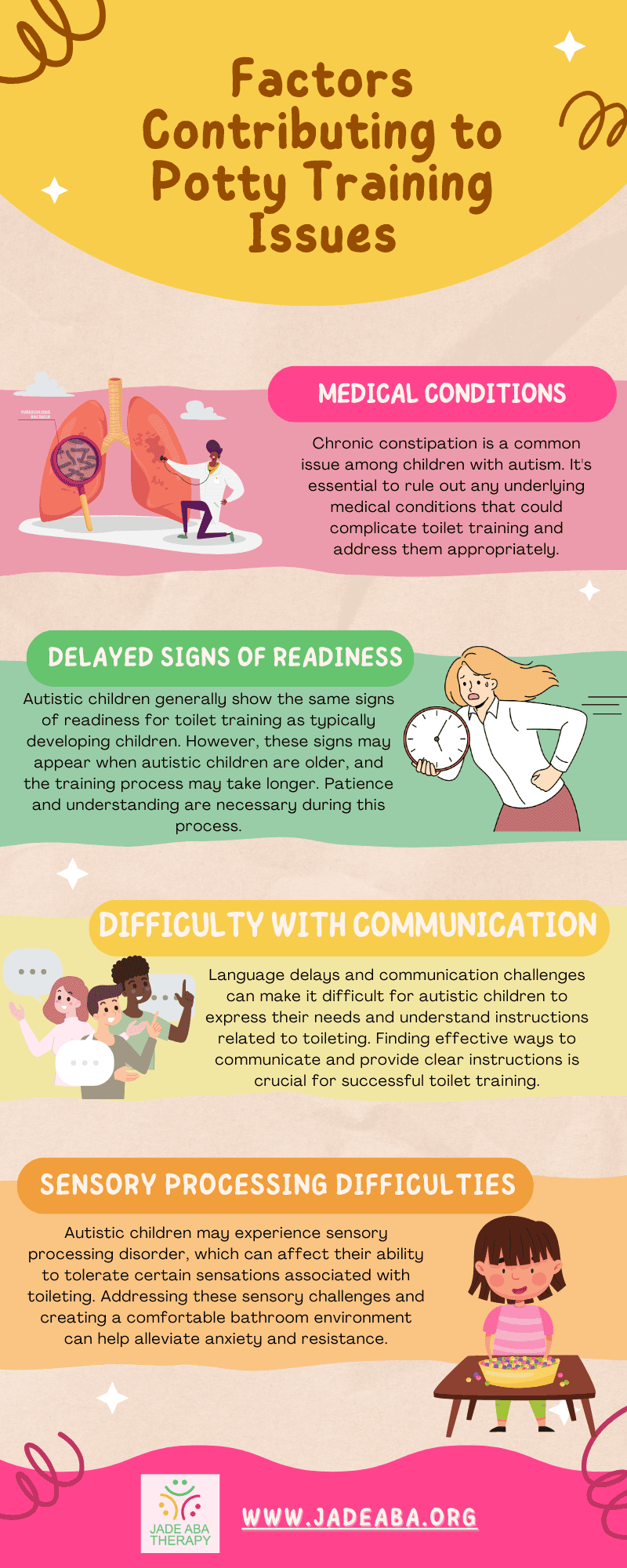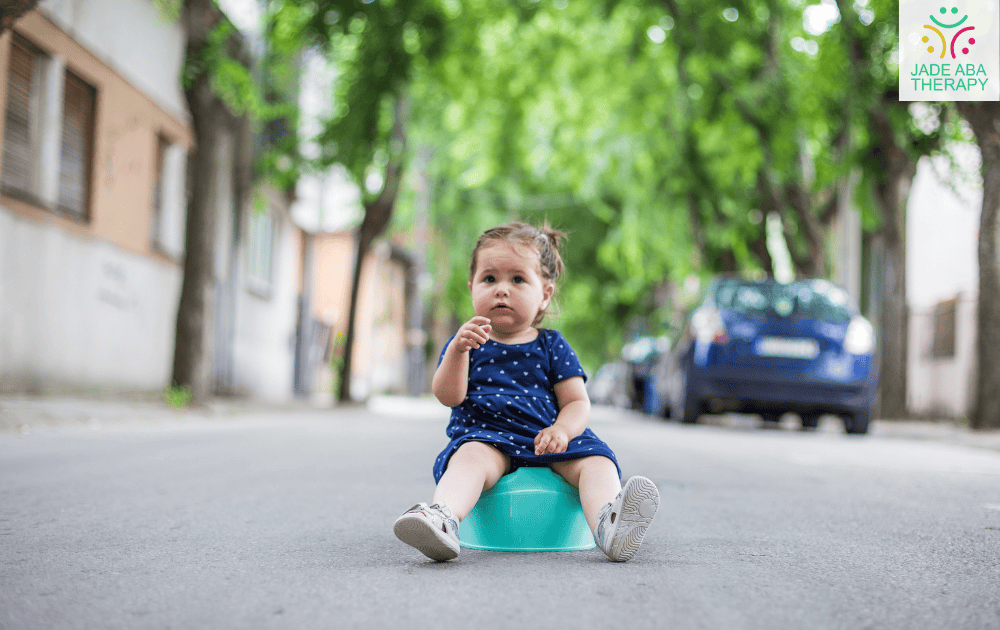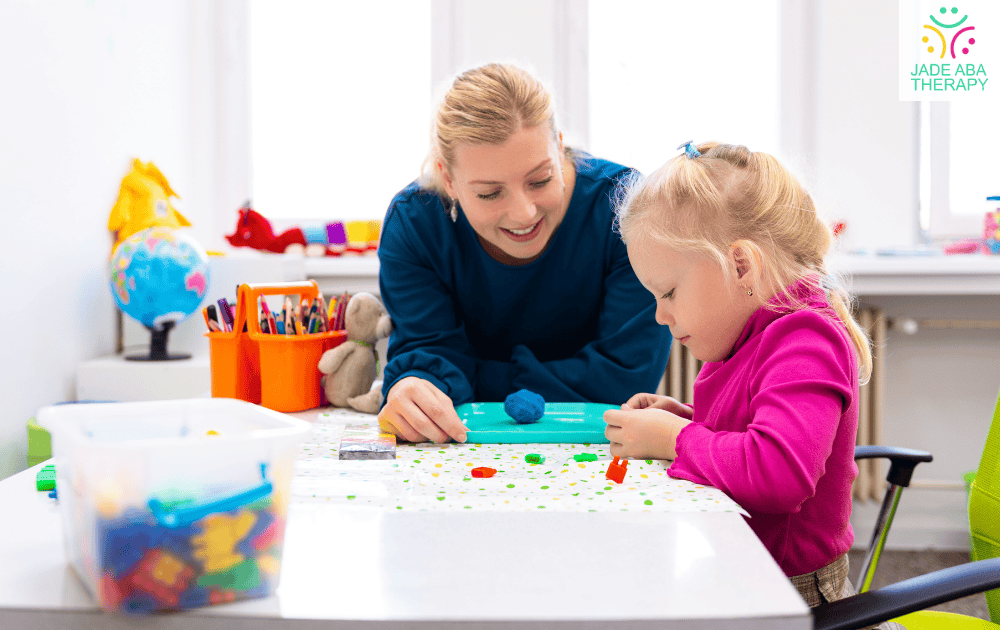Children with autism often face unique challenges when it comes to toilet training. As a parent, it is crucial to understand these challenges and the factors contributing to potty training issues to approach toilet training in a supportive and effective manner.
Most children with autism find toilet training particularly challenging due to various reasons. Some of the common challenges they face include:
- Sensory aversions: Sensory sensitivities can make the bathroom environment overwhelming for autistic children. The sounds, smells, and textures associated with toileting can be distressing, leading to resistance and avoidance.
- Interruptions from routines: Autistic children often thrive on predictable routines. Introducing toilet training can disrupt their established routines, causing anxiety and resistance to change.
- Fear of missing preferred activities: Autistic children may have preferred activities or objects that they are reluctant to interrupt, such as snacks or computer time. The fear of missing out on these preferred activities can result in oppositional behavior during toilet training attempts.

Factors Contributing to Potty Training Issues
In addition to the challenges mentioned above, there are several factors that contribute to potty training issues in children with autism. It’s important to consider these factors when developing strategies for successful toilet training.
Let’s look at each of them:

By understanding the specific challenges that autistic children face during toilet training and identifying the factors that contribute to these issues, parents and caregivers can develop effective strategies to support their child’s progress.
Effective Strategies for Potty Training
As far as potty training children with autism goes, there are effective strategies that can make a significant difference in their progress and success. Implementing these strategies allows parents and caregivers to help their children overcome challenges and develop important toileting skills.
There are three key strategies mainly used for this which are as follows:
Antecedent Supports
Introducing antecedent supports can be an effective strategy in helping children with autism overcome toilet training challenges. Antecedent supports involve shaping behavior, systematic desensitization, and avoiding reinforcement of unwanted behavior.
By gradually exposing the child to the toilet training process and providing supports that reduce anxiety or resistance, parents and caregivers can create a more comfortable environment for learning.
This may include using visual schedules, social stories, or visual cues to help the child understand the steps involved in toileting and reduce any sensory sensitivities they may experience.
Behavior Analysis and Functional Assessment
Behavior analysis and functional assessment are essential tools for understanding the underlying reasons for a child’s resistance or oppositional behavior during toilet training.
By conducting a functional behavior assessment, behavioral analysts can identify the antecedents, behaviors, and consequences associated with toileting challenges. This assessment helps professionals develop strategies to encourage positive behaviors and address any barriers that may be hindering the child’s progress.
Understanding the function of the child’s behavior can guide the development of individualized strategies to support their toilet training journey.
Positive Reinforcement Techniques
Positive reinforcement techniques are important for motivating and encouraging children with autism during the potty training process. Calm and encouraging praise can be highly effective in reinforcing desired behaviors and promoting progress.
That said, it is important to avoid reinforcing unwanted behavior by not providing attention or rewards when the child resists or engages in inappropriate behaviors during toilet training. Instead, focus on praising and rewarding the child for making incremental progress and successful attempts.
A reward system with clear expectations, such as using stickers or a small token, can be implemented to motivate the child and reinforce positive behavior.

Supporting Autistic Children During Potty Training
When potty training children with autism, it’s important to provide the right support and guidance. Every child is unique, and the process may take longer for autistic children compared to their typically developing peers.
In this section, we’ll talk about some strategies to support autistic children during potty training.
Signs of Readiness and Timing
Just like typically developing children, autistic children also show signs of readiness for toilet training. However, these signs might appear when autistic children are older, and the training process may take longer.
Some signs of readiness to look out for include:
- Showing an interest in the bathroom or toilet
- Demonstrating awareness of the need to use the bathroom
- Communicating physical cues or discomfort when needing to go
- Displaying the ability to follow simple instructions
It’s crucial to be patient and observe your child for readiness signs before starting the potty training process. Timing is key, and pushing a child before they are ready can result in frustration for both the child and the caregiver.
Utilizing Encouragement and Rewards
Encouragement, rewards, and praise play a vital role in motivating and reinforcing positive behavior during toilet training for autistic children. Using a reward system with clear expectations can be beneficial.
For example, you can create a sticker chart and reward your child with a sticker for successful attempts. This visual representation of progress can help your child stay engaged and motivated throughout the training process.
It’s essential to be consistent with the reward system and provide immediate reinforcement for successful toileting behaviors. This positive reinforcement helps your child understand the desired behavior and encourages them to continue practicing.
Using Social Stories and Visual Supports
Autistic children often benefit from visual supports and structured routines.
Social stories are a valuable tool that can aid in coping with challenging situations like toilet training. These stories can be created by professionals such as speech pathologists, occupational therapists, or teachers with experience in autism.
Such stories help children understand what to do in different scenarios and can alleviate anxiety or confusion.
Visual supports and schedules, such as the Picture Exchange Communication System (PECS), can also be beneficial during toilet training. These aids help remind the child of the steps involved in using the toilet, ensuring consistent training.
Visual schedules can include pictures or symbols representing each step, such as entering the bathroom, sitting on the toilet, and washing hands. These visual supports provide a clear and predictable structure, which can enhance understanding and independence.

Overcoming Sensory Sensitivities in Toilet Training
Toilet training can be particularly challenging for children with autism due to their sensory sensitivities. Understanding and addressing these sensitivities is crucial for successful toilet training.
Here are some key strategies that can be employed for that purpose:
Create Comfortable Environments
For children with autism, creating a comfortable environment is essential in facilitating toilet training. This involves making the bathroom a calm and positive space.
You can consider the following tips:
- Ensure the bathroom is well-lit but not overly bright, as harsh lighting can be overwhelming.
- Use calming colors and decorations in the bathroom to create a soothing atmosphere.
- Introduce familiar and comforting items, such as a favorite toy or sensory-friendly materials, to help the child feel more at ease.
- Maintain a consistent bathroom routine to provide a sense of predictability and reduce anxiety.
Making the bathroom environment comfortable and inviting allows you to help alleviate sensory challenges and create a positive association with toilet training.
Address Sensory Processing Disorder Challenges
Many children with autism also experience sensory processing disorder (SPD), which can impact their sensitivity to certain stimuli. To address these challenges during toilet training, consider the following strategies:
- Provide sensory supports, such as a footstool, to help the child feel stable and secure while sitting on the toilet. This can enhance their comfort and confidence.
- Use visual schedules or social stories to prepare the child for the sensory experiences they may encounter in the bathroom. These aids can help them better understand and cope with the sensations associated with toilet training.
- Gradually expose the child to different sensory stimuli in the bathroom, such as the sound of running water or the texture of toilet paper. Start with small exposures and gradually increase the duration and intensity to desensitize the child over time.
By addressing sensory processing disorder challenges, you can help the child navigate their sensory sensitivities and make the toilet training process more manageable.

Deal with Noise Sensitivities
Noise sensitivities, particularly to flushing toilets, can be a significant barrier to toilet training for children with autism. To mitigate this challenge, consider the following strategies:
- Use noise-blocking headphones or ear defenders to reduce the impact of loud noises in the bathroom. This can help create a quieter and less overwhelming environment for the child.
- Flush the toilet after the child has left the bathroom to avoid triggering their noise sensitivity. This way, they can focus on the other aspects of toilet training without the added stress of a loud flushing sound.
- Gradually introduce the sound of flushing toilets through exposure therapy. Start with recordings or videos of flushing sounds at a low volume and gradually increase the volume and proximity over time. This can help desensitize the child to the noise.
Implementing the following strategies lets you support children with autism in overcoming their sensory sensitivities and successfully navigating the toilet training process.